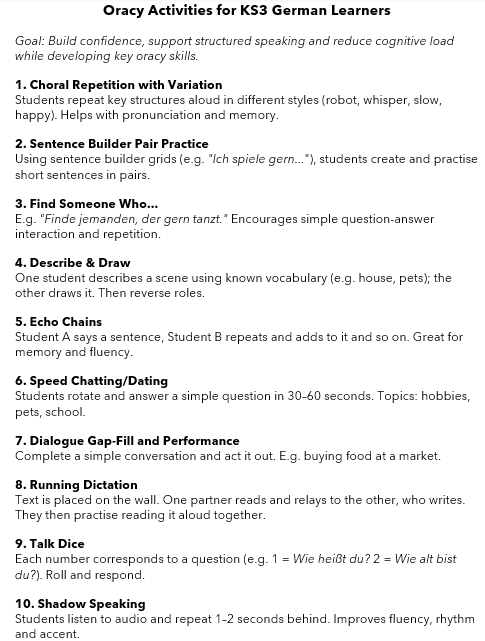Oracy in the Languages Classroom: Why Speaking Is So Much More Than Talking
- Silvia Bastow
- Sep 7
- 5 min read
When we talk about language learning, “speaking” often feels like the ultimate goal. It’s what learners and parents usually see as success: Can you have a conversation? Can you speak the language? But what we often fail to acknowledge is just how demanding speaking actually is; especially in a language we’re still learning.
Oracy - defined as the ability to express oneself fluently and grammatically in speech, is much more than parroting rehearsed sentences. It’s an intricate dance of cognitive, social and linguistic processes that stretch even our first language abilities. When we expect our students to speak fluently in a new language too soon, we risk overloading their cognitive systems and causing them to disengage. To foster oracy effectively in the languages classroom, we must first understand the complexity of what we’re asking our students to do.

What happens in the brain when we speak?
Speaking is one of the most complex motor tasks humans perform, it is a physiological feat involving over 100 muscles across the abdomen, throat and mouth. But that’s only the beginning.
Before the words ever leave our lips, the brain is doing a remarkable amount of behind-the-scenes work:
pictures what we want to say.
organises those ideas into meaningful chunks.
finds the right vocabulary and structures.
sends signals to initiate movement.
monitors and adjusts speech in real time.
And whilst doing all of this, we’re also:
listening to others
interpreting social and contextual cues
adjusting tone, register and speed to suit the situation
We’re doing all of this every time we speak, often without noticing it in our native tongue. But when we ask our novice students to do the same in a foreign language, we’re asking their brains to carry an even heavier load.
Here is what I mean:
The Cognitive Load of speaking another language
Now imagine layering on the following challenges:
Retrieving unfamiliar vocabulary
Applying grammatical rules that aren’t yet automatised
Getting the pronunciation right
Suppressing first-language interference
Navigating unfamiliar cultural conventions and rules
All of this has to happen at roughly 100 words per minute. No wonder students often freeze, hesitate, or default to silence. It's not a lack of effort! It’s a system overload like trying to carry too many shopping bags at once and struggling to move without dropping something.

What this means for the languages classroom
Recognising this complexity has profound implications for how we teach speaking in world languages:
1. Prioritise Listening before Speaking
Just as babies listen for hundreds of hours before uttering their first words, our students need ample exposure to comprehensible input before being expected to speak. Hearing vocabulary and structures in meaningful contexts helps build the mental representations they’ll later draw on when speaking.
2. Create low-stakes speaking opportunities
Rather than jumping into full-blown dialogues, start with structured output:
Sentence builders
Repetition drills
Dialogic reading
Choral response
Mini role plays with visual scaffolds
Gradually increase complexity as students gain fluency and confidence.
3. Celebrate accuracy and risk-taking
Too often, students are afraid to speak for fear of “getting it wrong.” Normalise errors as part of learning. Encourage students to take risks while giving them feedback that nudges them toward accuracy over time. Create the classroom culture of low threat.
4. Build in thinking time
Allow time to prepare thoughts before speaking through planning prompts, writing first, or using speaking frames. Fluency is built through retrieval and rehearsal, not pressure.
5. Rehearse routinely
Like any motor skill, speaking improves through repetition. Frequent, meaningful practice helps transfer language from working memory into long-term memory, reducing cognitive load over time.
Activities ideas to support oracy:
Low-stakes warm-up activities:
Ideal for lowering the affective filter and building speaking stamina.
Silent Rehearsal → Whisper → Speak - Students first rehearse a sentence silently, then whisper it, then say it aloud. Helps students ease into speaking, especially those who are reluctant and we have seen a lot more of that in our classrooms since the pandemic. They could practise in pairs or groups - using Think - Pair - Share technique, this could be scaffolded further by using Think - Write - Pair - Share.
Choral Repetition with Variation - Use different voices (robotic, slow motion, excited) for repeated speaking practice to reduce pressure.
Echo Chains - One student says a word or sentence, another repeats it and adds something new, forming a growing chain.
Structured speaking frames:
Use scaffolds that support fluency and reduce cognitive load.
Speaking Cards - Provide question cards with sentence starters (e.g. Was isst du gern? Ich esse gern…) to guide output.
Information Gap activities - Partner A has part of the information; Partner B has the other half. They must speak to complete the task (e.g. find the differences, complete the timetable).
Find Someone Who… (in TL) - Use a simple grid: "Find someone who… spielt gern Fußball / hat ein Haustier / mag Pizza". Encourages repeated use of simple Q&A.
Performance-based oracy tasks:
Great for motivation, fluency and prosody.
Mini Role-Plays with prompts - Contexts: at a café, in a shop, meeting someone new. Use cue cards or visuals to guide.
‘I’m the Expert’ Speaking Circle - Students sit in inner and outer circles. The inner circle explains something (e.g. their hobbies, their weekend) to rotating partners.
Language Theatre - Students write short skits or dialogues using target vocab structures. Focus is on performance, not perfection.
Listening–speaking integration:
Supports auditory processing and active speaking.
Dictogloss - Students hear a short text twice. They reconstruct it together, speaking aloud. Forces collaboration and accurate output.
Walking Dictation - One partner reads a text on the wall and relays it to the other who writes it down. Later, they read it out together.
Shadow Speaking - Students repeat what they hear a second or two behind the audio or the teacher (like an echo), improving fluency and pronunciation.
Games that encourage spontaneous talk:
Fun and engaging ways to reduce anxiety.
Talk Dice - Roll a die to get a question type: 1 = Wie heißt du? 2 = Wo wohnst du? 3 = Was machst du gern? (Can be tailored by topic.)
Speed Chatting / Dating - Set up short 1-minute “chats / dates” to discuss simple topics before rotating partners.
Describe & Draw - One student describes a picture in the target language; the other draws it.
Cognitive-aware speaking practice:
Recognises the load on learners’ brains.
Tiered Speaking Tasks - Start with sentence-level speaking, then scaffold toward free-flowing conversation. Example: word → sentence → question → follow-up.
Think Time + Speaking Buddies - Give time to prepare ideas silently, then rehearse with a buddy before speaking aloud to the class.
Language ‘Recycling’ Challenge - Set a challenge to reuse key vocabulary from previous lessons in current discussions.


Final Thoughts
Speaking is not just “talking.” It’s a high-order, whole-brain task that takes immense energy, especially in another language. If our students struggle to speak fluently early on, it’s not because they’re not capable. It’s because their brains are doing something extraordinary.
Be patient. Be structured. Be encouraging.
The ultimate goal is for speaking a new language to feel as natural and effortless as the first - but let's be realistic, that takes time, practice and a lot of compassion for the beautiful complexity of oracy and our students need to know this! It doesn't happen over night!




Comments